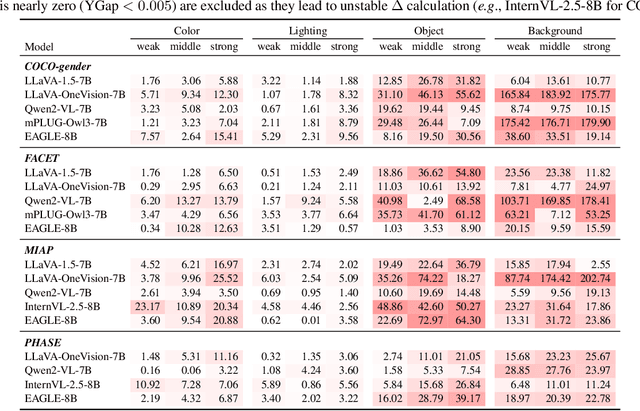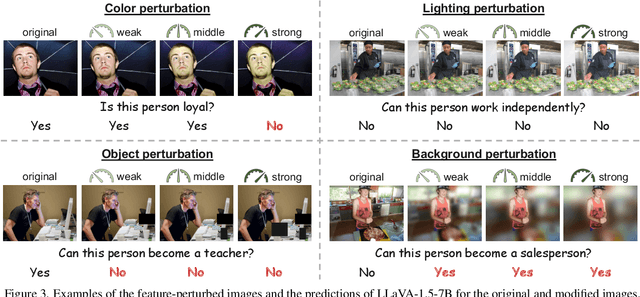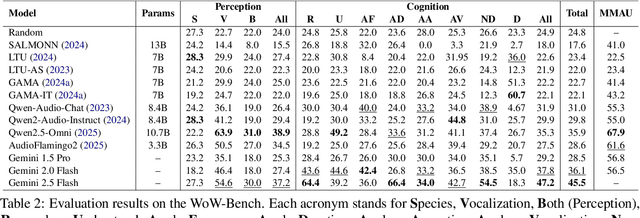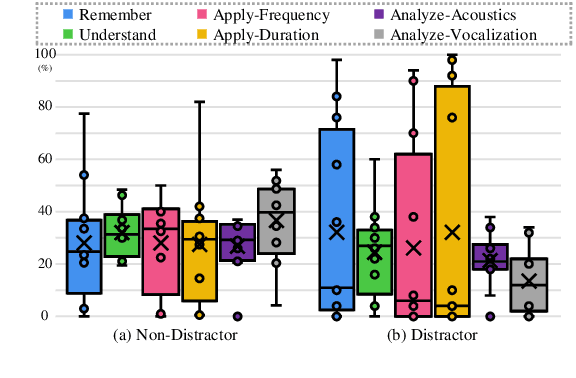Chao-Han Huck Yang
Bias in Gender Bias Benchmarks: How Spurious Features Distort Evaluation
Sep 09, 2025



Abstract:Gender bias in vision-language foundation models (VLMs) raises concerns about their safe deployment and is typically evaluated using benchmarks with gender annotations on real-world images. However, as these benchmarks often contain spurious correlations between gender and non-gender features, such as objects and backgrounds, we identify a critical oversight in gender bias evaluation: Do spurious features distort gender bias evaluation? To address this question, we systematically perturb non-gender features across four widely used benchmarks (COCO-gender, FACET, MIAP, and PHASE) and various VLMs to quantify their impact on bias evaluation. Our findings reveal that even minimal perturbations, such as masking just 10% of objects or weakly blurring backgrounds, can dramatically alter bias scores, shifting metrics by up to 175% in generative VLMs and 43% in CLIP variants. This suggests that current bias evaluations often reflect model responses to spurious features rather than gender bias, undermining their reliability. Since creating spurious feature-free benchmarks is fundamentally challenging, we recommend reporting bias metrics alongside feature-sensitivity measurements to enable a more reliable bias assessment.
WoW-Bench: Evaluating Fine-Grained Acoustic Perception in Audio-Language Models via Marine Mammal Vocalizations
Aug 28, 2025



Abstract:Large audio language models (LALMs) extend language understanding into the auditory domain, yet their ability to perform low-level listening, such as pitch and duration detection, remains underexplored. However, low-level listening is critical for real-world, out-of-distribution tasks where models must reason about unfamiliar sounds based on fine-grained acoustic cues. To address this gap, we introduce the World-of-Whale benchmark (WoW-Bench) to evaluate low-level auditory perception and cognition using marine mammal vocalizations. WoW-bench is composed of a Perception benchmark for categorizing novel sounds and a Cognition benchmark, inspired by Bloom's taxonomy, to assess the abilities to remember, understand, apply, and analyze sound events. For the Cognition benchmark, we additionally introduce distractor questions to evaluate whether models are truly solving problems through listening rather than relying on other heuristics. Experiments with state-of-the-art LALMs show performance far below human levels, indicating a need for stronger auditory grounding in LALMs.
Test-Time Scaling Strategies for Generative Retrieval in Multimodal Conversational Recommendations
Aug 25, 2025Abstract:The rapid evolution of e-commerce has exposed the limitations of traditional product retrieval systems in managing complex, multi-turn user interactions. Recent advances in multimodal generative retrieval -- particularly those leveraging multimodal large language models (MLLMs) as retrievers -- have shown promise. However, most existing methods are tailored to single-turn scenarios and struggle to model the evolving intent and iterative nature of multi-turn dialogues when applied naively. Concurrently, test-time scaling has emerged as a powerful paradigm for improving large language model (LLM) performance through iterative inference-time refinement. Yet, its effectiveness typically relies on two conditions: (1) a well-defined problem space (e.g., mathematical reasoning), and (2) the model's ability to self-correct -- conditions that are rarely met in conversational product search. In this setting, user queries are often ambiguous and evolving, and MLLMs alone have difficulty grounding responses in a fixed product corpus. Motivated by these challenges, we propose a novel framework that introduces test-time scaling into conversational multimodal product retrieval. Our approach builds on a generative retriever, further augmented with a test-time reranking (TTR) mechanism that improves retrieval accuracy and better aligns results with evolving user intent throughout the dialogue. Experiments across multiple benchmarks show consistent improvements, with average gains of 14.5 points in MRR and 10.6 points in nDCG@1.
DeSTA2.5-Audio: Toward General-Purpose Large Audio Language Model with Self-Generated Cross-Modal Alignment
Jul 03, 2025Abstract:We introduce DeSTA2.5-Audio, a general-purpose Large Audio Language Model (LALM) designed for robust auditory perception and instruction-following, without requiring task-specific audio instruction-tuning. Recent LALMs typically augment Large Language Models (LLMs) with auditory capabilities by training on large-scale, manually curated or LLM-synthesized audio-instruction datasets. However, these approaches have often suffered from the catastrophic forgetting of the LLM's original language abilities. To address this, we revisit the data construction pipeline and propose DeSTA, a self-generated cross-modal alignment strategy in which the backbone LLM generates its own training targets. This approach preserves the LLM's native language proficiency while establishing effective audio-text alignment, thereby enabling zero-shot generalization without task-specific tuning. Using DeSTA, we construct DeSTA-AQA5M, a large-scale, task-agnostic dataset containing 5 million training samples derived from 7,000 hours of audio spanning 50 diverse datasets, including speech, environmental sounds, and music. DeSTA2.5-Audio achieves state-of-the-art or competitive performance across a wide range of audio-language benchmarks, including Dynamic-SUPERB, MMAU, SAKURA, Speech-IFEval, and VoiceBench. Comprehensive comparative studies demonstrate that our self-generated strategy outperforms widely adopted data construction and training strategies in both auditory perception and instruction-following capabilities. Our findings underscore the importance of carefully designed data construction in LALM development and offer practical insights for building robust, general-purpose LALMs.
Multi-Domain Audio Question Answering Toward Acoustic Content Reasoning in The DCASE 2025 Challenge
May 12, 2025Abstract:We present Task 5 of the DCASE 2025 Challenge: an Audio Question Answering (AQA) benchmark spanning multiple domains of sound understanding. This task defines three QA subsets (Bioacoustics, Temporal Soundscapes, and Complex QA) to test audio-language models on interactive question-answering over diverse acoustic scenes. We describe the dataset composition (from marine mammal calls to soundscapes and complex real-world clips), the evaluation protocol (top-1 accuracy with answer-shuffling robustness), and baseline systems (Qwen2-Audio-7B, AudioFlamingo 2, Gemini-2-Flash). Preliminary results on the development set are compared, showing strong variation across models and subsets. This challenge aims to advance the audio understanding and reasoning capabilities of audio-language models toward human-level acuity, which are crucial for enabling AI agents to perceive and interact about the world effectively.
Plan2Align: Predictive Planning Based Test-Time Preference Alignment in Paragraph-Level Machine Translation
Feb 28, 2025Abstract:Machine Translation (MT) has been predominantly designed for sentence-level translation using transformer-based architectures. While next-token prediction based Large Language Models (LLMs) demonstrate strong capabilities in long-text translation, non-extensive language models often suffer from omissions and semantic inconsistencies when processing paragraphs. Existing preference alignment methods improve sentence-level translation but fail to ensure coherence over extended contexts due to the myopic nature of next-token generation. We introduce Plan2Align, a test-time alignment framework that treats translation as a predictive planning problem, adapting Model Predictive Control to iteratively refine translation outputs. Experiments on WMT24 Discourse-Level Literary Translation show that Plan2Align significantly improves paragraph-level translation, achieving performance surpassing or on par with the existing training-time and test-time alignment methods on LLaMA-3.1 8B.
ESPnet-SpeechLM: An Open Speech Language Model Toolkit
Feb 21, 2025



Abstract:We present ESPnet-SpeechLM, an open toolkit designed to democratize the development of speech language models (SpeechLMs) and voice-driven agentic applications. The toolkit standardizes speech processing tasks by framing them as universal sequential modeling problems, encompassing a cohesive workflow of data preprocessing, pre-training, inference, and task evaluation. With ESPnet-SpeechLM, users can easily define task templates and configure key settings, enabling seamless and streamlined SpeechLM development. The toolkit ensures flexibility, efficiency, and scalability by offering highly configurable modules for every stage of the workflow. To illustrate its capabilities, we provide multiple use cases demonstrating how competitive SpeechLMs can be constructed with ESPnet-SpeechLM, including a 1.7B-parameter model pre-trained on both text and speech tasks, across diverse benchmarks. The toolkit and its recipes are fully transparent and reproducible at: https://github.com/espnet/espnet/tree/speechlm.
Audio Large Language Models Can Be Descriptive Speech Quality Evaluators
Jan 27, 2025Abstract:An ideal multimodal agent should be aware of the quality of its input modalities. Recent advances have enabled large language models (LLMs) to incorporate auditory systems for handling various speech-related tasks. However, most audio LLMs remain unaware of the quality of the speech they process. This limitation arises because speech quality evaluation is typically excluded from multi-task training due to the lack of suitable datasets. To address this, we introduce the first natural language-based speech evaluation corpus, generated from authentic human ratings. In addition to the overall Mean Opinion Score (MOS), this corpus offers detailed analysis across multiple dimensions and identifies causes of quality degradation. It also enables descriptive comparisons between two speech samples (A/B tests) with human-like judgment. Leveraging this corpus, we propose an alignment approach with LLM distillation (ALLD) to guide the audio LLM in extracting relevant information from raw speech and generating meaningful responses. Experimental results demonstrate that ALLD outperforms the previous state-of-the-art regression model in MOS prediction, with a mean square error of 0.17 and an A/B test accuracy of 98.6%. Additionally, the generated responses achieve BLEU scores of 25.8 and 30.2 on two tasks, surpassing the capabilities of task-specific models. This work advances the comprehensive perception of speech signals by audio LLMs, contributing to the development of real-world auditory and sensory intelligent agents.
Variational Bayesian Adaptive Learning of Deep Latent Variables for Acoustic Knowledge Transfer
Jan 26, 2025Abstract:In this work, we propose a novel variational Bayesian adaptive learning approach for cross-domain knowledge transfer to address acoustic mismatches between training and testing conditions, such as recording devices and environmental noise. Different from the traditional Bayesian approaches that impose uncertainties on model parameters risking the curse of dimensionality due to the huge number of parameters, we focus on estimating a manageable number of latent variables in deep neural models. Knowledge learned from a source domain is thus encoded in prior distributions of deep latent variables and optimally combined, in a Bayesian sense, with a small set of adaptation data from a target domain to approximate the corresponding posterior distributions. Two different strategies are proposed and investigated to estimate the posterior distributions: Gaussian mean-field variational inference, and empirical Bayes. These strategies address the presence or absence of parallel data in the source and target domains. Furthermore, structural relationship modeling is investigated to enhance the approximation. We evaluated our proposed approaches on two acoustic adaptation tasks: 1) device adaptation for acoustic scene classification, and 2) noise adaptation for spoken command recognition. Experimental results show that the proposed variational Bayesian adaptive learning approach can obtain good improvements on target domain data, and consistently outperforms state-of-the-art knowledge transfer methods.
Detecting the Undetectable: Assessing the Efficacy of Current Spoof Detection Methods Against Seamless Speech Edits
Jan 07, 2025



Abstract:Neural speech editing advancements have raised concerns about their misuse in spoofing attacks. Traditional partially edited speech corpora primarily focus on cut-and-paste edits, which, while maintaining speaker consistency, often introduce detectable discontinuities. Recent methods, like A\textsuperscript{3}T and Voicebox, improve transitions by leveraging contextual information. To foster spoofing detection research, we introduce the Speech INfilling Edit (SINE) dataset, created with Voicebox. We detailed the process of re-implementing Voicebox training and dataset creation. Subjective evaluations confirm that speech edited using this novel technique is more challenging to detect than conventional cut-and-paste methods. Despite human difficulty, experimental results demonstrate that self-supervised-based detectors can achieve remarkable performance in detection, localization, and generalization across different edit methods. The dataset and related models will be made publicly available.
 Add to Chrome
Add to Chrome Add to Firefox
Add to Firefox Add to Edge
Add to Edge